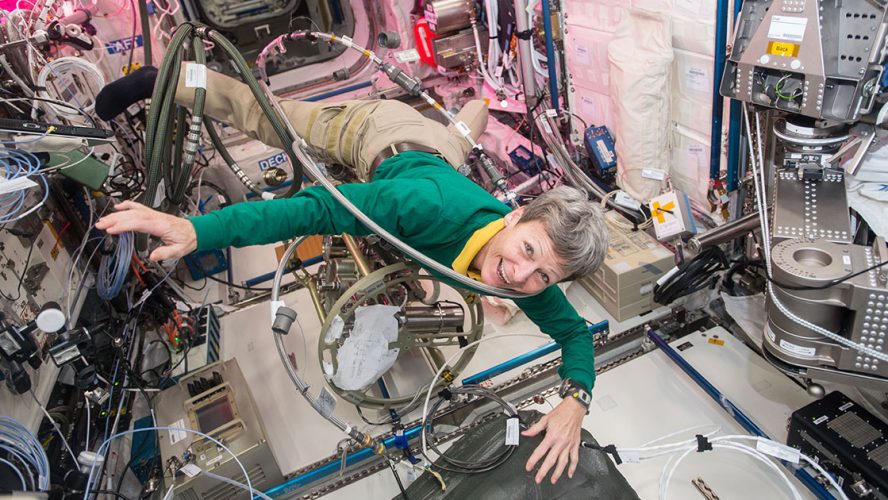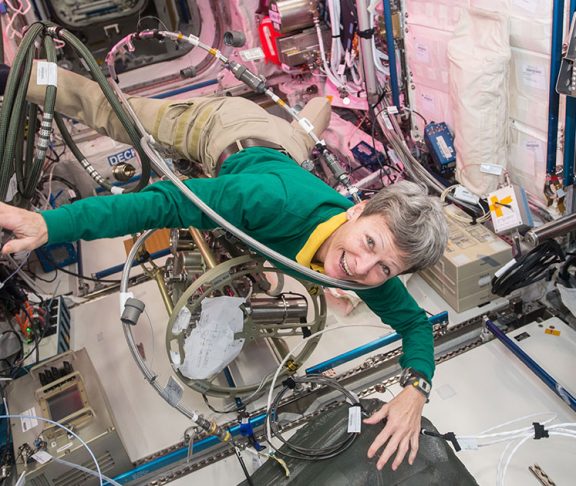While they don’t all physically work together, their relationships as fellow women in the male-dominated field have helped support each other.
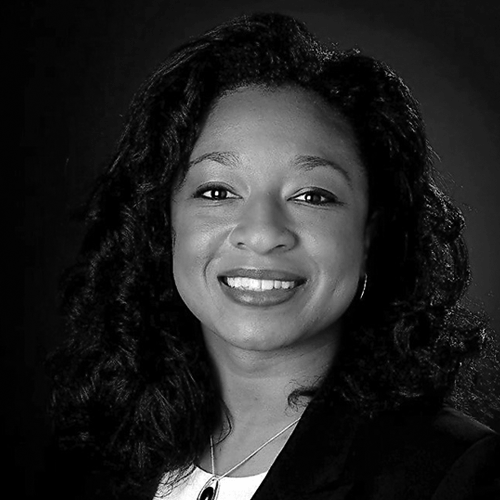
Christyl Johnson, Ph.D
Deputy Center Director for Technology and Research Investments
Can you explain in a few sentences your role at NASA?
I am the deputy center director for Technology and Research Investments. I am responsible for charting the course of our future, such as determining which science missions we want to pursue and establishing an integrated investment portfolio to enable those missions. This also includes transferring technologies we develop to the private industry for their use in commercializing new products and improving the quality of life for all.
You were the first African American woman deputy center director at NASA. Up until becoming the director of R&D for Goddard Space Flight Center, can you describe your experience as a minority female in the sciences?
In the physics program that I attended in undergraduate school, my professors showed no favoritism or difference in expectations based upon gender. However, once I got to grad school at Penn State in the engineering department, a world of differences was brought to light. Many times, I was in classes where I was the only female and the only minority in the classroom, and the examples used in classroom discussions were tailored to the male experience. I had the most eye-opening experiences regarding gender differences after entering the workforce at NASA. Even though I felt privileged every day to be serving our country in one of the greatest and most exciting agencies our country has to offer, I found myself having to work twice as hard and be twice as good to earn the respect that my male counterparts earned so easily. I found that there would always be one in the bunch that wanted to discredit females, but there were so many others that would intentionally support us, encourage us and mentor us. In an environment where the mission is so important and so difficult, out-of-the-box thinking is required in order to achieve the impossible. This environment demands diverse thinking, which means diverse people who bring diverse life experiences to the solutions they propose.
What is the absolute best part about working at NASA and the space industry?
Everyday, we achieve the impossible and help to improve the quality of life for all citizens in ways that they don’t even know. For example, we had to find a way for an astronaut on the International Space Station to cut metal in zero gravity with no assistance. The cutters that we developed to solve this problem are now called the “Jaws of Life” and are used by fire and rescue workers every day to cut roofs and doors off of automobiles to free accident victims who are trapped inside.
What are the biggest concerns regarding the gender gap for women in research? Is it a fear of feeling too masculine, deficient self-confidence, a lack of opportunity, the pay gap?
I believe it starts with getting girls in the pipeline very early. Young girls need to be exposed to STEM fields and careers in a fun, appealing way when they are in elementary or middle school. There are multiple issues that must be addressed along the pipeline, but once they get into the workforce, we must also make sure we have an environment that sustains them. They often are not paid salaries on par with their male counterparts, and they are often penalized for prioritizing family responsibilities. When hardworking women are faced with having to make a choice between rearing a family and climbing the ladder at work, we lose great talent.
What do you see is improving for women in research? What other innovations in your industry are exciting to you?
While there are still challenges that need to be addressed for women in research, we have seen more women in leadership positions across the industry. We have had two women directors at the National Science Foundation and our first woman Deputy Administrator at NASA. This year, I conducted my second ”Sustaining Women in STEM Roundtable” with participation of just over 160 participants from 50 government, industry, local and non-profit organizations, and 562 online participants from 10 countries. I am seeing a significantly broadening interest in corporate, government and even academic leadership to identify, incorporate and share best practices to recruit, retain and promote women in STEM postitions.
Did you have a mentor when you began to conduct research or do you still have a mentor? Do you believe that mentorship programs can play a big role in helping girls take their idea and turn it into something tangible?
From the first day that I officially started working at NASA, I have always had a mentor. Mentors throughout my career have provided research guidance, served as technical sounding boards, provided career path guidance, and have even opened doors for growth and promoton opportunities for me. I have always known that trying to navigate through life alone in this kind of profession would be a big mistake, so I have worked hard to develop an array of mentors to help me with my journey. These mentors have been invaluable to me. I would definitely say that I don’t think I would be where I am today if I had not had the support and guidance of key mentors in my life. I have also been a mentor to multiple people throughout my career, and have seen remarkable result from mentorship programs.
Where do you see yourself in five years? In five years
I would love to be in a position where I am responsible for bringing technology solutions to the table to address a wide array of challenges globally.
Investing in research and our researchers is paramount to our continued global advancement and competitiveness. The United States is the #1 country in the world who spends the most money on research at $44 billion dollars, and accounting for 44% of market research revenue in 2015. Yet only 3% of scientific Nobel Prize winners and only 28% of the world’s researchers are women because topics like gender bias still affect the research industry. What insight or advice do you have to a young woman considering a career as a researcher, particularly in STEM?
Go for it. Know who you are and what you bring to the table, and don’t let anyone change that. No one can tell you what is possible for you and what is not. No one can realize your dreams but you, and no one can stop you from achieving them but you. What you bring to the table as a woman is unique. There is power in the difference and uniqueness that is you. Own that, and use it to make this world a better place.
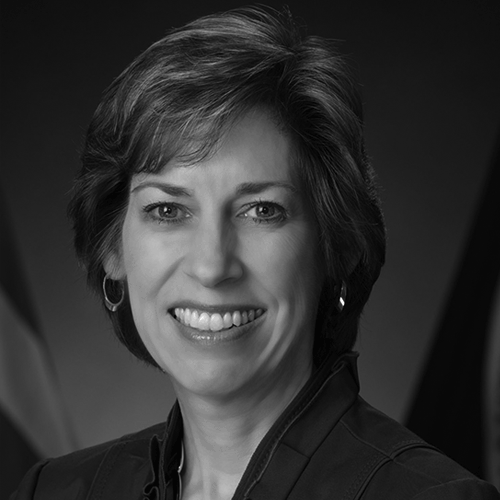
Ellen Ochoa, Ph.D.
Veteran Astronaut and 11th Director of NASA’s Johnson Space Center
From you childhood education to becoming the Johnson Space Center’s first Hispanic director — and its second female director — can you describe your experience as a female in the sciences?
Most striking is that there were very few women. Many times, as an undergraduate physics student or a graduate student in engineering, I was the only woman in the class. In the beginning, it was somewhat lonely and intimidating, but as I got to know the other students and professors, it became more comfortable. It probably helped that I usually got the highest grade in the class. I did receive a lot of encouragement from some of my professors, as well as people that I worked for — all men — which I greatly appreciate. I do think it’s important to have processes that promote fair competition. For example, the Ph.D. orals at Stanford (in 1981) consisted of 10 separate one-on-one sessions with professors. The Q&A was oral or sometimes a blackboard was used, then erased, so there was no record of how the student answered, only the score received from the professor. Some professors were heard to say aloud that they had never passed a woman and never would — and there was no way to challenge that.
What does a typical day look like for you as Director of Johnson Space Center? What is the absolute best part about working in the space industry?
One of the best parts of the position is the variety of activities I get to be involved in. Today, I participated in a discussion of flight readiness associated with an upcoming flight to the International Space Station, discussed progress on the Orion spacecraft development, tagged up with leaders of our technical and mission support organizations, and handed out ice cream to people to thank them for helping out during Hurricane Harvey. Our employees also took a group photo in support of the Houston Astros in the World Series, and our astronauts on ISS sent down a message of support as well. I love being part of an endeavor that provides benefits to humanity by expanding scientific knowledge, developing new technologies that can be used in a variety of industries, exhibiting leadership through international collaboration and inspiring others. Yesterday I got to participate in the dedication of an elementary school named after me. How cool is that.
What do you see is improving for women in research? What other innovations in your industry are exciting to you?
In at least some areas of science and engineering, the numbers of women have increased, though there’s a long way to go. In addition, there’s more attention on having research universities and organizations that are funded with federal research dollars comply with both Title IX of the Education Act and Title VI of the Civil Rights Act. You can check out NASA’s Mission STEM website to see what NASA is doing and how we are promoting best practices. I’m lucky to work with some incredible women scientists and advocates for science: Dr. Kate Rubins, an astronaut and cancer biologist who sequenced DNA in space for the first time; Dr. Peggy Whitson, an astronaut and biochemist who participated in hundreds of science experiments on ISS and holds the American record for time in space; Dr. Eileen Stansbery, the chief scientist at Johnson Space Center; and Dr. Julie Robinson, the ISS Program scientist.
And as a member of the National Science Board (NSB), I’m fortunate to work with NSB Chair, Dr. Maria Zuber, and National Science Foundation Director, Dr. France Cordova. These women inspire many others in science!
Who did you look up to as inspiration when you began your career at NASA as a Research Engineer at Ames Research Center? Did you have a mentor when you began to conduct research or do you still have a mentor?
I got some early advice from a woman researcher, Suzanne Stotlar, who I worked with as an undergraduate summer student at Los Alamos Scientific Laboratory (now Los Alamos National Laboratory). She encouraged me to consider graduate school and even mentioned a particular researcher at Stanford —Joe Goodman, who ended up becoming my primary Ph.D. Advisor. He and Bert Hesselink were really supportive, and I’ve stayed in touch with them throughout my career. My supervisor at Ames Research Center, Dr. Henry Lum, gave me a lot of opportunities to gain visibility early in my NASA career. Both mentors and sponsors have an important role to play in nurturing the careers of scientists and engineers.
What insight or advice do you have to a young woman considering a career as an inventor, astronaut or researcher?
Pick a Ph.D. advisor who has demonstrated strong support of his/her students of both genders. Find other professors and researchers who can be mentors or supporters. And I hope young women will also be inspired by the stories of the scientists I mentioned.
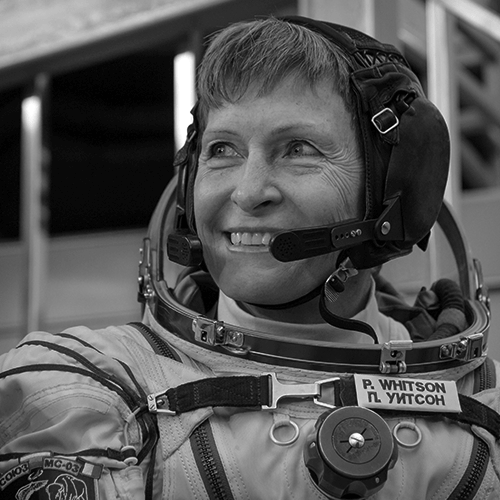
Peggy Whitson, Ph.D
Astronaut, American Record-Holder for Most Spaceflight Time, NASA
With 665 days in space under your belt, you currently hold the American record for most spaceflight, and the record for women worldwide. Up until becoming record-breaking NASA astronaut, can you describe your experience as a female in the sciences in comparison to your male peers?
In graduate school, the male-to-female biochemistry researcher ratios were close to identical. However, when I first started working at NASA, there were many times when I was the only female or among the very few in meetings. Luckily that is not the case now at NASA.
What is the absolute best part about working at NASA and the space industry?
Flying in space.
On your most recent mission to space, Expedition 50/51/52, you contributed to hundreds of experiments in biology, biotechnology, physical science and Earth science. What was this experience like, with this mission not only breaking records, but also conducting research at the International Space Station?
I was named the first science officer of the ISS during Expedition 5. While I was able to conduct many investigations then, the “flavor” of the science has matured. During this expedition, we were conducting more complex and skill-based studies than we did on my earlier expeditions. My favorites involved the tissue culture of STEM cells, lung cancer cells, cardiac STEM cells and osteoblasts. Other very interesting research we conducted was looking at fluid/air mixture separations in hydrophobic and hydrophilic columns and combustion experiments, and growing plants.
What do you see is improving for women in research? What other innovations in your industry are exciting to you?
I think the fact that there are more and more women in science to serve as role models for younger people is improving the field all the time. I know for certain that having strong women mentors in college, graduate school and NASA let me know that my goals in science were achievable. The more women in these roles, the better it will be for those who follow.
Who did you look up to as inspiration when you began your career as a researach biochemist at NASA’s Johnson Space Center? Did you have a mentor when you began to conduct? Do you believe that mentorship programs can play a big role in helping girls take their idea and turn it into something tangible?
The female science mentors at NASA were Nitza Cintron and Carolyn Huntoon. Both offered me opportunities that developed me as a leader as well as a scientist. Shannon Lucid, Ellen Baker and Rhea Seddon were among the female astronauts selected in the first class of female astronauts in 1978. A biochemist and two medical doctors made it seem feasible for me to pursue my goal to become an astronaut. As I mentioned above, I have been very lucky to have strong female role models throughout my life. I think it is very important to pay it forward and mentor those who follow after. I have really enjoyed mentoring the newly assigned astronauts.
What insight or advice do you have to a young woman considering a career as an astronaut or researcher, (or in your case an astronaut researcher)?
Unfortunately, gender bias still exists. However, my advice is to not get hung up on the fact that it exists. I have always found success in working hard and demonstrating “my stuff.” Competence and dedication will pay off.

Sandra C. Coleman
Vice President, NASA Programs for Orbital ATK Washington Operations
Elaborate on meeting Dr. Wernher von Braun as a girl scout and how this sparked your dream of working in the space industry.
In 1950, Dr. Wernher von Braun’s Rocket Team had moved from Fort Bliss, Texas, to Redstone Arsenal near Huntsville, Alabama, where they built the army’s Jupiter ballistic missile. Von Braun became one of the most prominent spokesmen of space exploration in the United States during the 1950s. My Dad worked in intelligence and security at Redstone Arsenal in the same building a Dr. von Braun. When I was 11 years old, my dad arranged for my Girl Scout Troop to meet Dr. von Braun. He showed us a model of a rocket that he said would take us to the Moon someday. I was mesmerized by this story, following him through my junior and high school years. In 1960, his rocket development center transferred from the army to the newly established NASA and received a mandate to build the giant Saturn rockets. Accordingly, von Braun became the first center director of NASA’s Marshall Space Flight Center and the chief architect of the Saturn V launch vehicle, the superbooster that would propel Americans to the Moon. I graduated from high school in 1965 and was offered a GS-3 secretarial position in the NASA-MSFC Saturn V Instrument Unit Project Office. Dr. Frederick Duerr, one of the German rocket scientists, was my manager and as such, Dr. von Braun would occasionally drop by his office. He still seemed bigger than life every time I encountered him, just as he did when I was an 11-year-old girl scout. One of the biggest honors of my life was to be a part of that team that landed on the moon, even if I was just a secretary.
Can you describe your experience as a female in the? What was it like navigating a system that wasn’t built for women?
I cannot emphasize enough the opportunities that NASA provided to me throughout the years. They encouraged me with full financial support for my BS degree in accounting, the pre-requisites for an Engineering degree and full-time graduate school at the University of Alabama in Tuscaloosa for a master’s degree in industrial engineering. This was in the 80s when there was no push to promote women in aerospace. After we landed on the Moon in 1969, I was one of 40 selected to serve on the original Space Shuttle Task team. In high school, I was only one of two girls in the accelerated math class of about 20 students, but they allowed us in based on our grades, so no discrimination. I was the only woman in the industrial engineering class at the University of Alabama, but was treated with dignity and respect. Since I was on a sabbatical from NASA, I was highly respected. I attended the classes, studied really hard and graduated with honors.
What is the absolute best part about working in the space industry?
Working with the smartest and most success driven people in the world. Being a part of the team that landed on the moon in 1969, and developed and operated the Space Shuttle servicing the International Space Station for decades, was beyond my wildest dreams. NASA has been voted as the best place in government to work for many years. It’s true.
What are you currently excited about in your industry?
There has never been a better time to select a career in a STEM field, whether for a woman or a man. NASA is building a rocket and capsule that will take us back to the moon and to Mars, which will open the heavens for research. Every field of research — space science, Earth science, physics, medicine and computer Science — will be in high demand.
Who did you look up to as inspiration when you began your career at NASA? Did you have a mentor, or do you still have a mentor?
I had many mentors after I began work at NASA, but all were men. The Space Team is a very close-knit family. We had very difficult tasks and the managers needed high performers, and they did not care if they were women or men. Because I was a trailblazer, I probably see myself as the mentor rather than a mentee.
What insight or advice do you have as a young woman considering a career as a researcher, particularly in the STEM fields?
My advice is to go after your dreams and don’t let anyone tell you cannot achieve them because you are a woman. You have to take control of your own career. That means that you have to study diligently to prove that you’re qualified, and you have to work really hard to always be on top of all data, issues, recommendations and next steps to achieve the goals of the organization.
